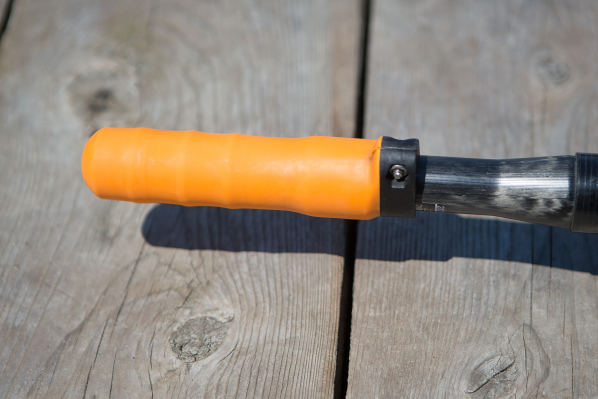How to Choose Your Oar or Scull Grip

In a boat, the athlete has three points of contact: the seat, foot stretcher, and oar grips. Grips provide feedback to the athlete on technical execution. It is a sensitive connection for the athlete, allowing a “feel” for the water.
Concept2 offers a variety of sweep and scull grips so that athletes can choose materials and diameters that fit them best. This “fit” involves a personal preference: some athletes row very “light in the hands” and feather the blade only in the fingertips. Other athletes prefer a more robust feel to control the oar.
We offer many different materials that range in feel and durability. There is no consensus on a “best” grip material in terms of tackiness, ability to handle certain conditions, or what may be gentlest on skin. Athletes’ hands endure a lot in rowing due to a large combination of factors. Olympian Andréanne Morin provides some suggestions on proper oar handling.
The grip is what is in the athlete’s hands. It is installed onto the handle, which is inserted into the oar shaft. Unlike the handle, the grip is not built into the oar’s construction; they can easily be changed. Grips are made to be replaced as a wearing part. Daily maintenance of grips will help them maintain their properties, disinfected and clean.
Grips that feel slimy, hardened, or have changed color or texture are due a replacement. We also recommend changing out any grips that pose a health hazard due to mildew, mold, bacteria or other unsanitary conditions. (Grips with black residue that cannot be removed are overdue for replacement.)
Here are some basic principles to help you choose a grip:
Size
Concept2 grips range in size from 32mm to 37mm (sculls and sweep outer grip) and sweep inner grips ranging from 40mm to 46mm.
- As a general rule, you can expect that smaller athletes such as youth and smaller women prefer smaller size grips.
- Medium grips fit a wide range of athletes and are popular for club equipment where there may be a range of users sharing oars. Our most popular grips are the orange contoured (33.5 mm) and green medium grips (34.5 mm).
- Thick grips (35 mm or larger) are generally used by men with large hands.
Material
We offer a variety of materials; each has proven to give athletes control of feathering the oar, security on the drive, and accuracy at both catch and release.
- Green rubber grips are firm and smooth.
- Contoured orange grips are the same material as the green rubber grips, but have radial finger-sized contours and a brushed texture.
- Azure blue and ice blue grips have longitudinal lines.
- Black rubber grips have a bit of “give” and tackiness.
- Microfiber suede grips have a soft velvety feel; some athletes prefer them wet to dry.
- Blue cellular grips are foamy and spongy.
- Wood veneer grips are smooth; the surface can be lightly sanded to offer more texture. They cannot be scored.
Durability
Grips will wear over time with use. How oars are cared for and stored will also affect the life of your grips. Indoor dry storage is recommended for oars: Ultraviolet light, dirt, dust and moisture can alter grips’ properties.
For all grips: be sure to wash your hands after applying sunscreen. We recommend that athletes avoid using tape on their hands or wearing rings while rowing.
- Rubber grips (green, azure blue, contoured orange, ice blue, black rubber) are durable and more resistant to the elements than other materials.
- Black rubber grips age quickly with exposure to sunlight. This may result in the surface layer of the grip coming off on your hands while you row, indicating they should be replaced.
- Microfiber suede requires more frequent replacement than our other grip options, but they are inexpensive to replace (no tools required!). With normal use, microfiber suede grips are expected to last 6-12 months.
- Blue cellular grips require more frequent cleaning to retain their grip properties. The frequency of cleaning blue cellular grips will depend on your rowing environment; warm, wet or dirty conditions will force more frequent cleaning of grips.
- Wood veneer grips are wood: they will react to moisture and humidity and should be stored dry. The porous material accumulates oil and dirt over time. The surface can be lightly sanded to offer more texture.
Familiarity
Many athletes prefer to row with what is familiar: what they learned with or what they row with now. If you’re changing between boats and oars frequently, your hands may prefer a grip that is familiar. A familiar grip gives you security in your stroke and also may reduce irritation between different surfaces and sizes. Some athletes may be more sensitive than others, so we suggest finding what works best for you.
Purchasing Grips
All new Concept2 oars and sculls include grips. (Wood veneer grips for sweep are the only grip option that incurs an additional charge). Concept2 oars and sculls can be purchased with a bare core instead of a grip; this allows you to add another manufacturer’s grip of your choosing. Replacement grips can be ordered online or by calling us at 800.245.5676. For assistance with fitting replacement grips to older oars, please give us a call.
